本篇文章主要是手动分析栈的溢出情况,并且去掉了相关的检查代码,我们下面就是通过简单的示例,来分析整个流程,首先看代码如下:
代码文件为:test_stack.c
1
2
3
4
5
6
7
8
9
10
11
12
13
14
15
16
17
18
19
20
21
22
23
24
25
26
27
28
29
30
31
32
33
34
35
36
37
| #define _CRT_SECURE_NO_WARNINGS
#include <windows.h>
#include <conio.h>
#include <stdio.h>
#include <process.h>
#include <string.h>
void foo(const char* input)
{
char buf[4];
strcpy(buf, input);
}
void bar(void)
{
printf("Augh! This program have been hacked by MoreWindows!\n");
_getch();
exit(0);
}
int main(int argc, char* argv[])
{
printf("Address of main = %p\n", main);
printf("Address of foo = %p\n", foo);
printf("Address of bar = %p\n", bar);
char szbuf[50] = "12341234";
DWORD* pbarAddress = (DWORD*)&szbuf[8];
*pbarAddress = (DWORD)bar;
foo(szbuf);
return 0;
}
|
1. 准备编译环境
- visual studio 2019
- Debug/x86
- 使用C编译器编译
- 去掉栈检查,JMC等
1. 配置
指定C编译器:
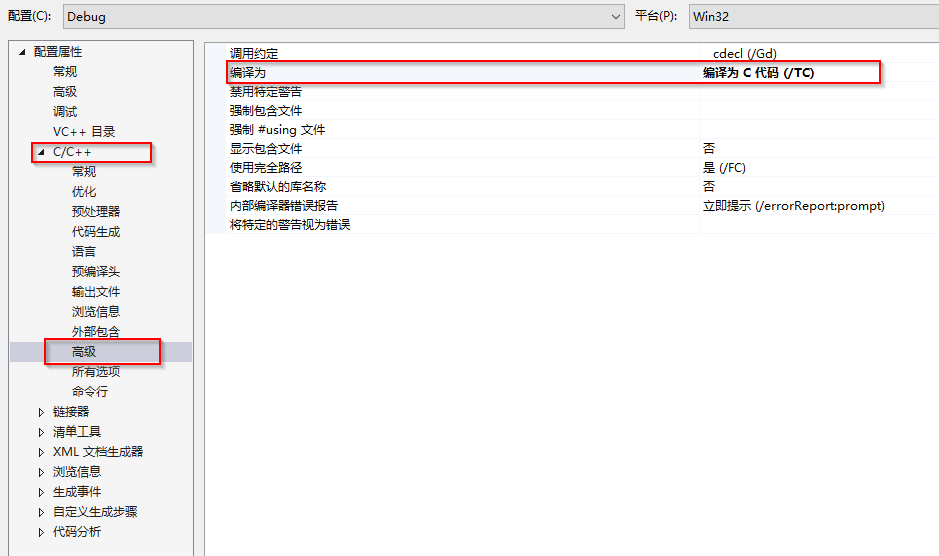
去掉基本运行时检查
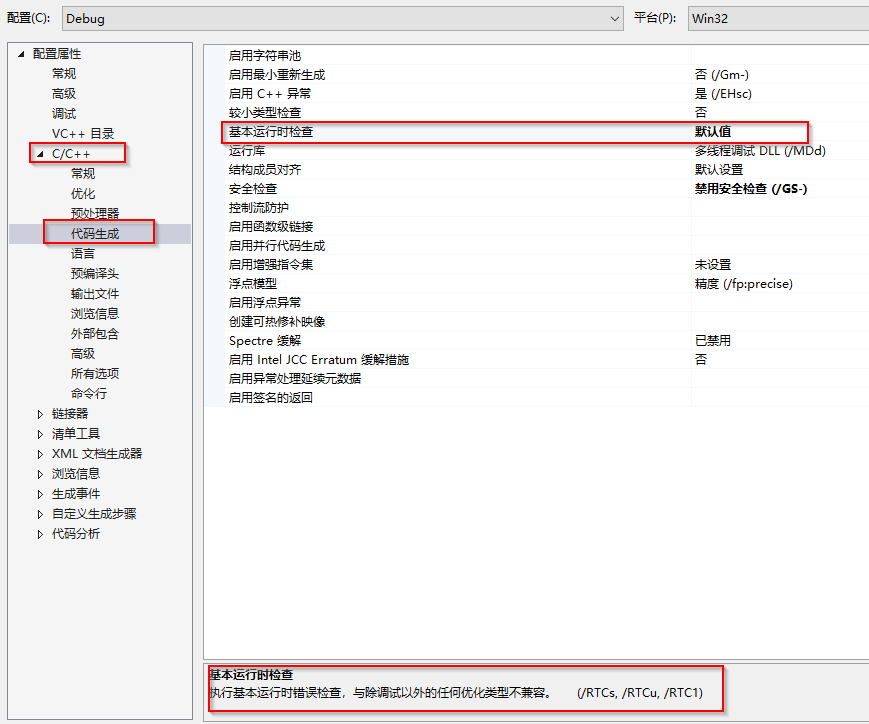
具体的rtc检查,生成的函数,可以参考文章:https://blog.csdn.net/magictong/article/details/6306820
去掉缓冲区检查
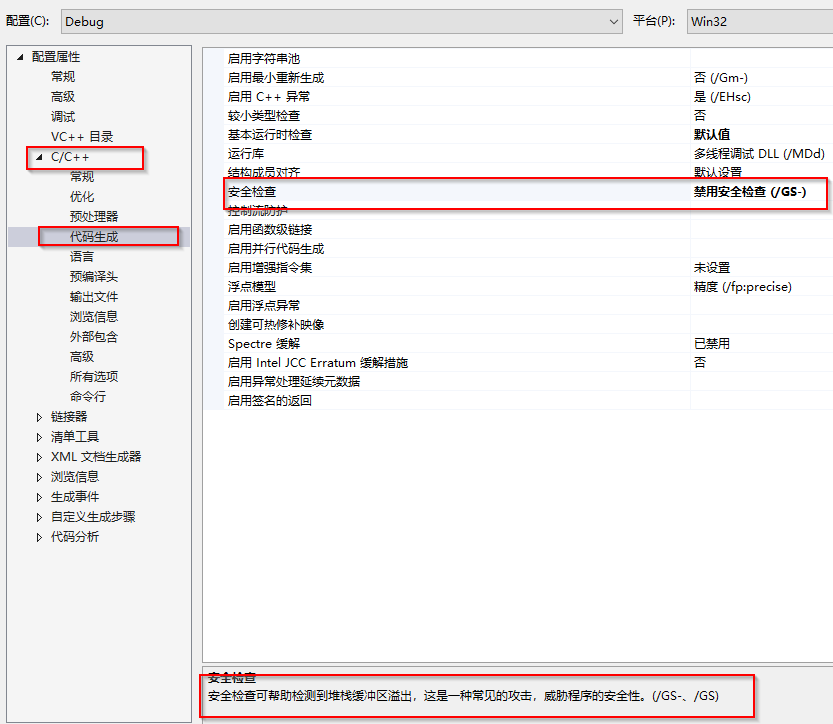
去掉整个作用就是去掉我们在反汇编中经常能看到的函数:___security_cookie
去掉JMC选项
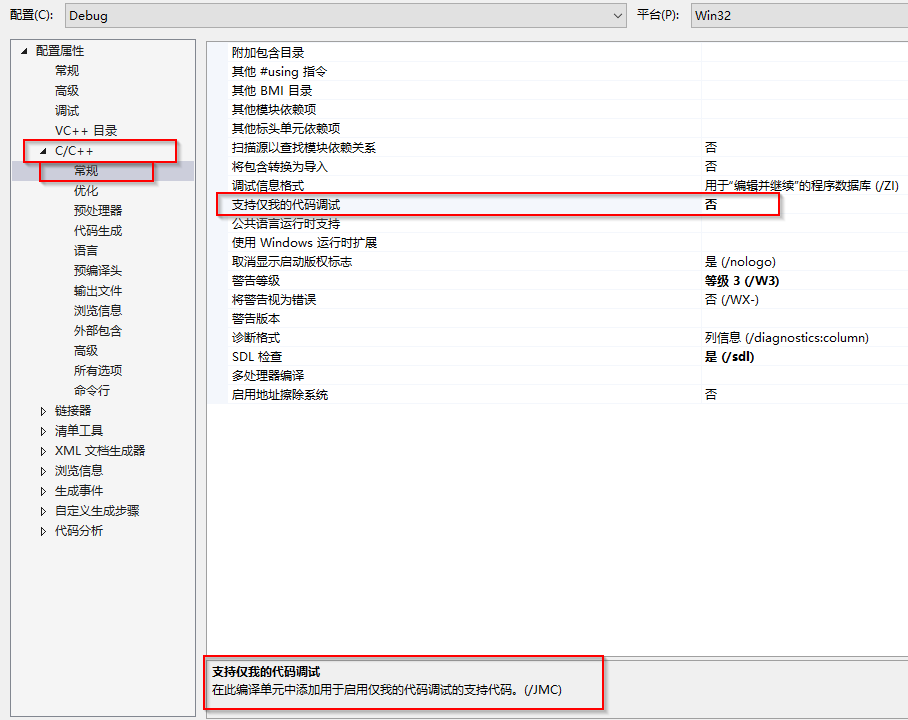
JMC选项一个Debug调试过程中的对于PDB文件的一种修饰,可以查看文章:https://learn.microsoft.com/en-us/cpp/build/reference/jmc?view=msvc-170
上面的配置都完成之后,我们就可以生成程序了,然后调试程序,就可以看见反汇编结果。
2. 反汇编并调试
调试过程中的反汇编结果:
1
2
3
4
5
6
7
8
9
10
11
12
13
14
15
16
17
18
19
20
21
22
23
24
25
26
27
28
29
30
31
32
33
34
35
36
37
38
39
40
41
42
43
44
45
46
47
48
49
50
51
52
53
54
55
56
57
58
59
60
61
62
63
64
65
66
67
68
69
70
71
72
73
74
75
76
77
78
79
80
81
82
83
84
85
86
87
88
89
90
91
92
93
94
95
96
97
98
99
|
int main(int argc, char* argv[])
{
005B1920 push ebp
005B1921 mov ebp,esp
005B1923 sub esp,78h
005B1926 push ebx
005B1927 push esi
005B1928 push edi
printf("Address of main = %p\n", main)
005B1929 push offset _main (05B12DFh)
005B192E push offset string "Address of main = %p\n" (05B7B70h)
005B1933 call _printf (05B10CDh)
005B1938 add esp,8
printf("Address of foo = %p\n", foo)
005B193B push offset _foo (05B127Bh)
005B1940 push offset string "Address of foo = %p\n" (05B7B8Ch)
005B1945 call _printf (05B10CDh)
005B194A add esp,8
printf("Address of bar = %p\n", bar)
005B194D push offset _bar (05B11F9h)
005B1952 push offset string "Address of bar = %p\n" (05B7BA8h)
005B1957 call _printf (05B10CDh)
005B195C add esp,8
//构造字符串,前8个填充字符,再跟一个bar()函数的地址。
char szbuf[50] = "12341234"
005B195F mov eax,dword ptr [string "12341234" (05B7BC4h)]
005B1964 mov dword ptr [szbuf],eax
005B1967 mov ecx,dword ptr ds:[5B7BC8h]
005B196D mov dword ptr [ebp-30h],ecx
005B1970 mov dl,byte ptr ds:[5B7BCCh]
005B1976 mov byte ptr [ebp-2Ch],dl
005B1979 push 29h
005B197B push 0
005B197D lea eax,[ebp-2Bh]
005B1980 push eax
005B1981 call _memset (05B114Fh)
005B1986 add esp,0Ch
DWORD* pbarAddress = (DWORD*)&szbuf[8]
005B1989 mov eax,1
005B198E shl eax,3
005B1991 lea ecx,szbuf[eax]
005B1995 mov dword ptr [pbarAddress],ecx
*pbarAddress = (DWORD)bar
005B1998 mov eax,dword ptr [pbarAddress]
005B199B mov dword ptr [eax],offset _bar (05B11F9h)
foo(szbuf)
005B19A1 lea eax,[szbuf]
005B19A4 push eax
005B19A5 call _foo (05B127Bh)
005B19AA add esp,4
return 0
005B19AD xor eax,eax
}
void foo(const char* input)
{
005B1880 push ebp
005B1881 mov ebp,esp
005B1883 sub esp,44h
005B1886 push ebx
005B1887 push esi
005B1888 push edi
char buf[4]
strcpy(buf, input)
005B1889 mov eax,dword ptr [input]
005B188C push eax
005B188D lea ecx,[buf]
005B1890 push ecx
005B1891 call _strcpy (05B120Dh)
005B1896 add esp,8
}
void bar(void)
{
005B1810 push ebp
005B1811 mov ebp,esp
005B1813 sub esp,40h
005B1816 push ebx
005B1817 push esi
005B1818 push edi
printf("Augh! This program have been hacked by MoreWindows!\n")
005B1819 push offset string "Augh! This program have been ha@"... (05B7B30h)
005B181E call _printf (05B10CDh)
005B1823 add esp,4
_getch()
005B1826 call dword ptr [__imp___getch (05BB174h)]
exit(0)
005B182C push 0
005B182E call dword ptr [__imp__exit (05BB178h)]
}
|
分析:
我们运行程序到调用 foo 函数, 如下图:
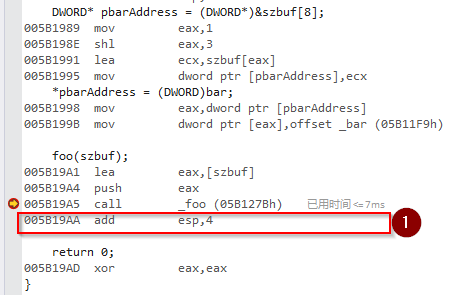
暂时的输出如下:
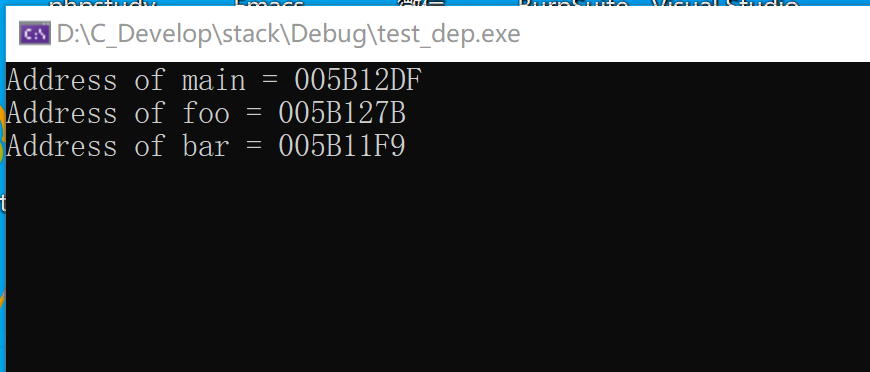
通过上图,我们要记住一点,调用 foo 函数后面的地址,这个是汇编 call _foo 的返回地址,第一张图 ① 的位置: 005B19AA add esp,4。
我们运行程序,进去到 foo 函数,如下图:
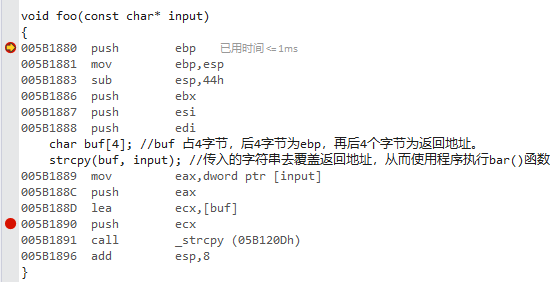
我们通过查看 esp 寄存器,查看栈中的数据:
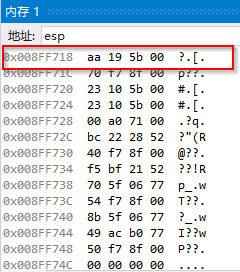
能看到 esp 地址的数据的第一值是 aa 19 5b 00 也就是 005b19aa 这个地址就是我们上面看到的 call _foo 函数的下一个地址,也就是 call 之后,压入栈的返回地址。
我们继续运行程序,我们要获取buf变量的位置,因为是局部变量,本身变量存在于栈中,下图:
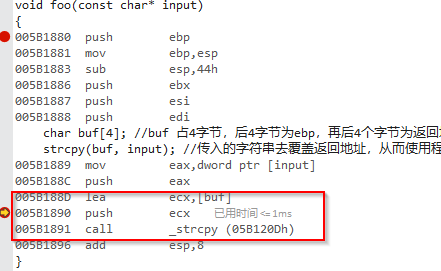
我们获取到的 ecx 寄存的值就是 buf 的缓冲区地址:008FF710
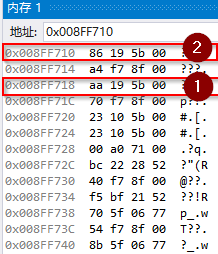
我们通过上面,知道 ① 的位置就是返回地址的位置:0x008FF718 aa 19 5b 00 ?.[.

而 ② 的位置就是 buf 缓存区位置:0x008FF710, 其中的值是随意填充的,没有影响。
我们继续运行程序,如下图:
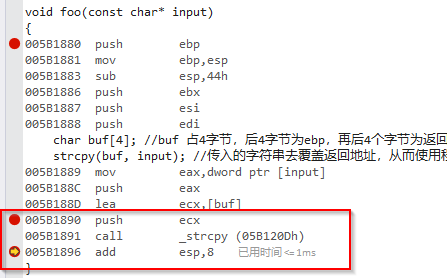
我们完成了 strcpy 函数的执行,然后观察现在 buf 的位置的数值情况,如下图:
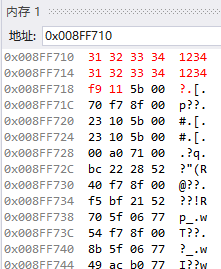
我们看到 buf 地址的位置已经背填充了值,本身的程序代码是这样的:
1
2
3
4
5
6
|
char szbuf[50] = "12341234";
DWORD* pbarAddress = (DWORD*)&szbuf[8];
*pbarAddress = (DWORD)bar;
foo(szbuf);
|
buf 本身填充的数据有两个部分组成,一个是字符数据:"12341234", 一个是 bar 函数的地址,这个地址我们通过最上面的输出,可以看到如下:
1
2
3
| printf("Address of main = %p\n", main);
printf("Address of foo = %p\n", foo);
printf("Address of bar = %p\n", bar);
|

我们继续看上面的执行完成后的内存栈图,
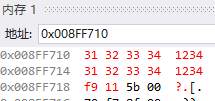
注意观察这三个地址:0x008FF718, 0x008FF714, 0x008FF710
第2个地址:0x008FF714 是什么呢? 在 buf 和 返回地址之间这个压入栈的数据是什么呢?其实也是很好理解,我们从 foo 函数的汇编就可以看出来,如下:
1
2
3
4
5
6
7
8
| void foo(const char* input)
{
005B1880 push ebp
005B1881 mov ebp,esp
005B1883 sub esp,44h
005B1886 push ebx
005B1887 push esi
005B1888 push edi
|
其实这个地方就是 push ebp 的操作。所以在返回地址和buf之间的位置。
那么我们继续执行,看看会出现什么效果?
首先执行到 foo 函数的最后,如下:
1
2
3
4
5
6
7
8
9
| 005B1891 call _strcpy (05B120Dh)
005B1896 add esp,8
}
005B1899 pop edi
005B189A pop esi
005B189B pop ebx
005B189C mov esp,ebp
005B189E pop ebp
005B189F ret
|
我们查看 ret 汇编指令的说明(Intel IA-32文档):
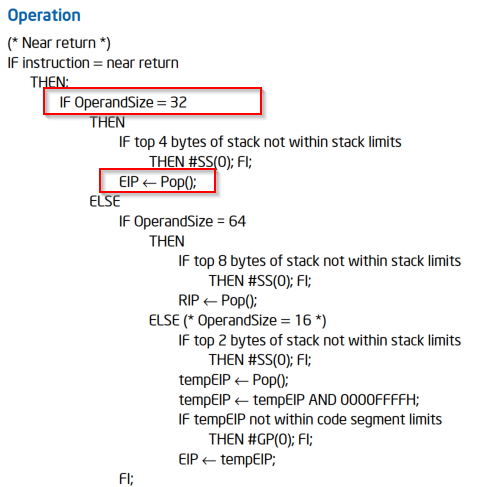
因为是32位程序,所以 ret 执行指令最终执行后是:EIP ← Pop(); 说明会把栈返回的数据返回给 EIP 寄存器,这个也就是代码执行的下一个执行存储的寄存器。
因为上面已经说明了, 把返回地址修改为了 bar 函数的地址:0x008FF718 f9 11 5b 00

那么 foo 返回后,也就是要执行 bar 函数了,这个也是能看到的确实是执行了 bar 函数:
1
2
3
4
5
6
| void bar(void)
{
printf("Augh! This program have been hacked by MoreWindows!\n");
_getch();
exit(0);
}
|
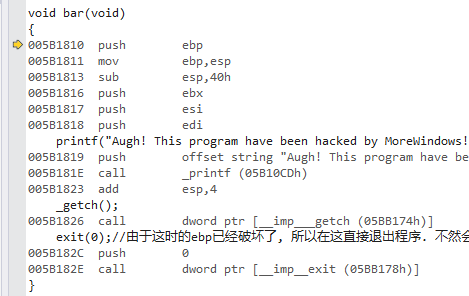
我们继续执行,看看能不能输出 printf 函数,如下图:
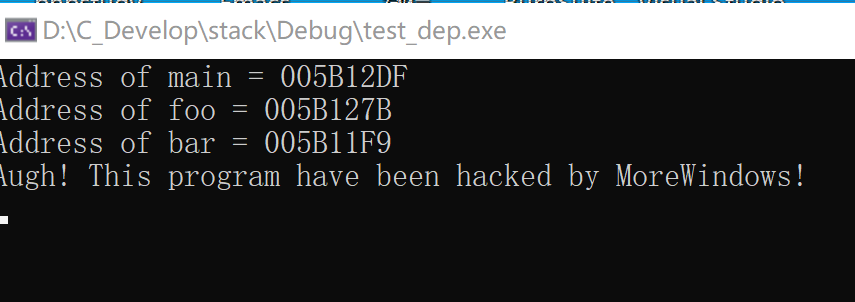
已经看到了,确实执行了, 并输出了信息。
3. 总结
我们通过上面的分析,就是一个完整的栈溢出漏洞的程序执行过程, 但要注意,我们去掉的几乎所有的栈检查和运行时检查,这里只是做为一个演示,观察怎么通过溢出覆盖了返回地址的。后续的文档,我们还会基于这个文章,做payload的分析工作,通过输出的方式弹出对话框。


















